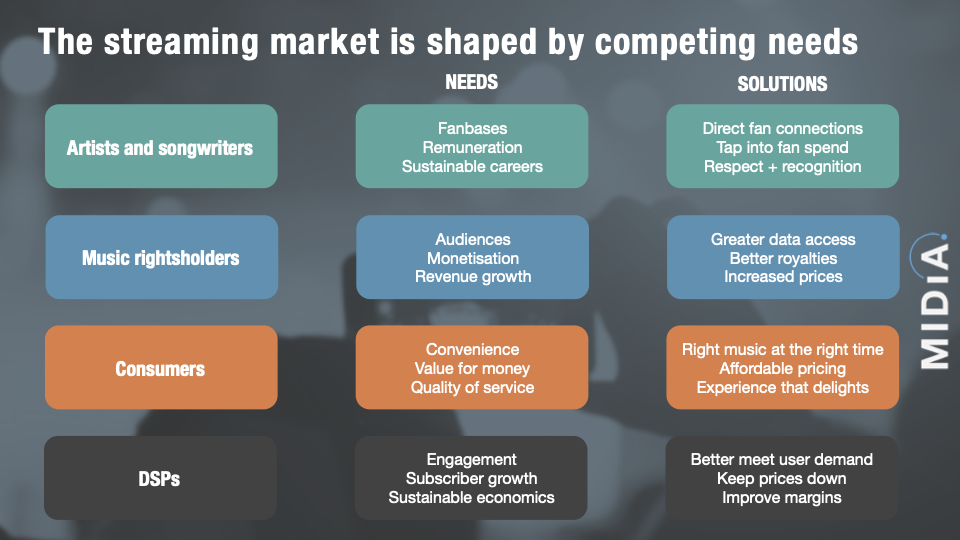(Hypebot) — After Universal and Deezer’s royalty proposal made headlines, Mark Mulligan of consultancy MIDiA explained that much more needs to be considered to fix the over-arching problems troubling music streaming.
by Mark Mulligan from the Music Industry Blog
UMG and Deezer’s artist-centric royalty proposal got the amount of attention both parties probably wanted, if not necessarily the type of attention they were after. However, the intent was to kick-start an industry debate, and that objective was clearly achieved. Yet, while the discussion has understandably focused on royalties (as, after all, it is a royalty system), these are more symptom than cause. Streaming royalties are not adding up because streaming is not adding up. Fixing royalties is only part of the solution.
In the early days of streaming, DSPs provided platforms for listening to music. Over time they have become places for consuming audio. As streaming mainstreamed, its role as successor to retail became subsumed by its role as music radio’s replacement. Passive playlists, lean-back listening, functional music, and ‘noise’ are a series of inevitable second-order consequences, as streaming chases the needs of consumers, following the behavioral data. All in stark contrast to when radio programmers and digital store managers chose what consumers got. In those days, it was a case of the public wants what the public gets, now the public gets what the public wants. The problem is that what the public wants creates a system that neither creators nor rightsholders want. Consumers have, at least in part, chosen this path.
Perhaps, as Steve Jobs was fond of saying, “it’s not the customer’s job to know what they want” or as Henry Ford (may or may not have) said “if I had asked my customers what they wanted they would have said a faster horse”. But whether you believe consumer choice should shape product strategy or not, consumer-led innovation is the defining characteristic of today’s digital world. This means that any innovation that looks to push against prevailing behavior risks can alienate the very customer base that the system depends upon. So how do we square the proverbial circle?
Solutions must understand the audience’s needs
Many years ago, my former employer, Forrester Research, devised the fantastic POST framework for defining product strategy:
- People: First, understand your customers and their needs
- Objectives: Next, identify what you want to achieve
- Strategy: Then, shape your strategy
- Technology: Finally, decide what technology fits the bill
Too often, this framework is done in reverse. Just think of the endless succession of ‘new tech’ start-ups that try to superimpose ill-fitting use cases onto their products. Technology desperately searching for a use case is one of the main reasons new tech, like the metaverse, VR and NFTs, follow the boom-bust-rebuild arc of the hype cycle. The risk with trying to superimpose new royalty structures on today’s streaming world (whether that be user centric, fan centric, artist centric, or whatever else) is that they look to solve supply-side needs (i.e., those of creators and rightsholders) first and demand-side (i.e., consumer) issues either last or not at all. Art may fuel the streaming machine, but consumers drive it (even if that means they benefit from self-driving much of the time).
At its heart, the streaming economy is shaped by diverse and often competing needs. Any successful system with diverse stakeholder needs operates by striking a pragmatic balance of meeting those needs. But a truly good compromise means that neither party is truly happy. This is the challenge that streaming faces today.
A brutal assessment of streaming would be that no one is happy. Every stakeholder, except perhaps the consumer, has beef with how streaming operates. All of which means that any fixes (at least those that will succeed) will need to deliver some form of benefit to all stakeholders, big and small. And that means tackling the underlying behavioral dynamics of streaming, from which today’s royalty issues come.
Streaming has two main problems.
A common refrain is that there is simply too much music. But the issue is dealing with quantity, rather than quantity itself being the problem. No one complains that there are too many search results on Google. The reasons quantity is seen as streaming’s problem are twofold:
- With so many releases, it is hard to cut through
- In a zero-sum royalty system, more (content) means less (royalties) per stakeholder
Factors like ‘noise’, functional music, and generative AI are not problems in themselves, they are problems because they accentuate both of these issues.
Introducing the algorithm multiplier
Adopting a two-tier royalty system will not solve either problem in itself. The long tail will still be there. Listening will still be fragmented. Royalties are a supply-side issue, not a demand-side one. And it is the demand side that is causing the ‘problem’ by spending time listening to an ever more diverse volume of music. If you want to change behavior to pull the behavior levers, not the remuneration levers. One way this could be done is by implementing an algorithm multiplier that applies a higher weight to successful artists. Thus ensuring success breeds success. But (and this part is crucial), this algorithm multiplier should be geared for all tiers of success. So, just as a superstar artist’s hit would get amplified, so would a <1,000-stream artist’s song that is doing exceptionally well when measured against other <1,000-stream artists. How does Google deal with the vast volume of search results? It prioritizes the good ones. The algorithm multiplier would surface the best of every tier of artist. Quantity stops being a problem, because quality will be pushed to the surface, regardless of scale.
The consumer wins (better music), the DSPs win (better user satisfaction), creators and rightsholders win (quality cuts through the clutter and gets a larger share of royalties).
The algorithm multiplier would fix many of today’s problems, but it would not be enough on its own. More needs to be put into the system to give all stakeholders more income and consumers more chances to be fans. MIDiA believes that $2 artist subscription streaming bolt-ons is one such way of achieving this, putting more value (both monetary and experience) into the system. Segmenting artist development and marketing across the platform landscape is another.
Streaming royalties clearly need an overhaul, but they must be done in concert with a reboot of the underlying behavioral architecture. Unless this happens, the artist and fan economies may end up decoupling from the streaming economy. Perhaps that will be a good thing. Perhaps not. But what it will not be is a predictable, low-risk future.






























